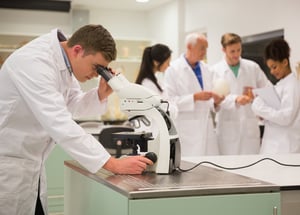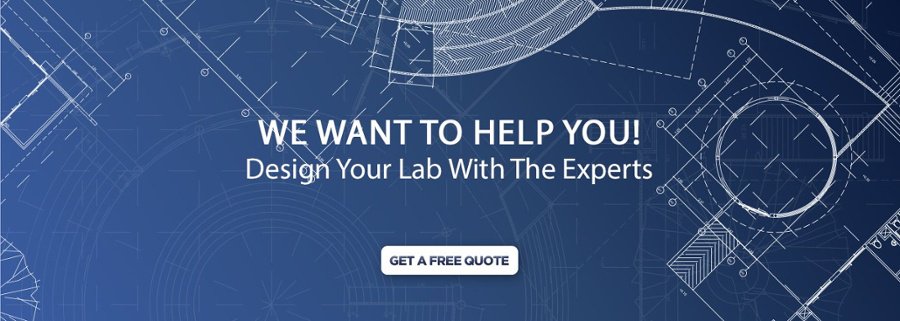Laboratories are full of checklists … safety checklists, procedural checklists, training and certification checklists, and more. Checklists are a natural part of this meticulous environment where details matter.
When setting up a new laboratory, it can be easy to overlook the basics of what type of science lab equipment you will likely need onhand. Yet these basic pieces can play an important role in how well your workspace operates, impacting multiple aspects of your lab, from safety to efficiency.
Do you have these lab tools and features on your equipment checklist?
Lab Safety Equipment Checklist
If something goes wrong, it’s critical to have the right lab equipment in place to ensure your employees remain safe. Lab safety checklists are great tools to help employees make sure they have lab safety equipment on hand to address these emergencies.
employees remain safe. Lab safety checklists are great tools to help employees make sure they have lab safety equipment on hand to address these emergencies.
While every lab uses different chemicals, substances and equipment, and has different procedures in place, here are some important emergency lab safety supplies:
- Fire extinguishers (mounted near doorways, fully charged and unobstructed)
- Fire blankets
- Eyewash centers
- Safety showers
- Emergency lights
- Chemical spill kits
- Evacuation route signs
- Telephones with access to 911 services
- Emergency information posters
- First aid kits
Chemical spill kits have their own checklist of supplies that should be included, such as:
Chemical spill kits can be purchased ready-made or you can construct a kit by purchasing the supplies separately and placing them together in one place. Kits should include items like:
- Disposable nitrile gloves
- Caution tape
- Hazardous waste bags and tags
- Neutralizing materials
- pH paper
- Plastic bags
- Mercury in-line vacuum trap kit
- Personal protective equipment (PPE)
- Dustpan and broom
Some of the most important pieces of lab safety equipment found in science labs are preventative rather than reactionary. Personal protective equipment, or PPE, are required in many laboratories, though which pieces are used on a regular basis varies based on your lab’s application. Some common pieces of PPE include:
- Clean room garments like lab coats, coveralls and full body suits
- Eye protection like lab safety glasses, goggles and face shields
- Gloves
- Protective hearing devices
- Hard hats
- Respirators
- Safety shoes and protectors
- Surgical face masks
You can read more about the lab safety equipment on these checklists in our article, Lab Safety Supplies Checklist.
Workspace Checklist
Creating an efficient workspace in a laboratory is necessary to maintain a high level of productivity. While a workspace checklist isn’t a traditional checklist you may find in a laboratory, lab managers can use this list as a reminder when designing spaces for their employees and deciding which pieces of lab equipment to include in the workspace.
workspace checklist isn’t a traditional checklist you may find in a laboratory, lab managers can use this list as a reminder when designing spaces for their employees and deciding which pieces of lab equipment to include in the workspace.
Here are some aspects to consider to optimize workflow and to ensure you have the right pieces of lab equipment and supplies in your design:
Workstation: The workstation itself is often the central hub for experimentation and discovery. Beyond providing a physical space for researchers to work, an appropriately-designed workstation plays a pivotal role in promoting efficiency, safety and ergonomics.
Questions to ask yourself include:
- Is my workstation ergonomically-friendly? Does it promote lab safety by minimizing physical strain and ensuring that all essential safety equipment and tools are easily accessible? An adjustable height lab table can make lowering and raising the surface of a workstation easier for employees, allowing them to adjust their work areas based on their own personal comfort levels.
- Does my workstation have enough storage? An industrial workbench with storage should offer ample space to organize and store laboratory equipment, chemicals and supplies, contributing to a clutter-free and efficient workspace.
- Is the lighting in my workstation adequate and appropriately positioned? Proper lighting is crucial for accurate observations and data collection in a laboratory setting. Ensure that your workstation is well-lit to enhance visibility and reduce eye strain.
- Have I considered the electrical and data connectivity needs of my workstation? Ensure that your workstation has convenient access to power outlets and data ports to support the operation of scientific instruments, computers and other equipment.
- Do I have the right lab countertop? The choice of lab countertop material is crucial for both safety and durability. In some labs, it’s important to consider whether you need a material to be chemical-resistant, bacteria-resistant, moisture-resistant or resistant to other harsh conditions. You may need to consider laboratory work surfaces like phenolic resin, epoxy resin or chemical laminate.
- Does my lab have ESD concerns? Electrostatic discharge, which can damage sensitive electronic components and equipment, can be a serious challenge in the lab. Industrial ESD workbenches can help minimize the risk of electrostatic discharge by providing a controlled grounding system and dissipative work surfaces.
Chairs: An often overlooked component of a lab workstation, chairs are an equally important part of a workspace. Qualities to consider when choosing chairs include material, comfort and adjustability. In labs, you may want to consider materials that are resistant to harsh chemicals and substances, such as chemical-resistant polyurethane or easy-to-clean vinyl. You may also need to invest in an ESD chair if electrostatic discharge is a concern.
Again, ergonomics should be a top priority, so look for chairs that are adjustable and promote comfort.
Storage: While many think of science lab equipment as beakers and flasks, storage solutions are needed to hold this equipment. Examples of storage solutions include:
- Shelving
- Laboratory cabinets
- Under-bench storage
- Drawer systems
- Pegboards
- Waste storage
It’s important to choose the right material for many of these storage solutions as well. Common materials used in labs include steel and stainless steel because of their resistance to chemicals and moisture.
Checklist For Other Pieces Of Science Lab Equipment
In addition to science safety equipment and equipment that helps optimize your workspace, there are several other tools and instruments that can help meet your specific research needs. Depending on the nature of your experiments, you may need the following science lab equipment:
- Microscopes: Choose the appropriate type of microscope (compound, stereo, electron) for your research, with features like magnification, illumination and imaging capabilities that meet your requirements.
- Centrifuges: Select centrifuges that can accommodate various sample sizes and types, from microcentrifuges for small volumes to high-capacity floor models for larger samples.
- Spectrophotometers: Ensure you have spectrophotometers, both UV-Visible and infrared, for accurate measurements of absorbance and transmittance in chemical and biological samples.
- Analytical Balances: Precision balances are crucial for accurate measurements, so choose models with the necessary precision and capacity for your work.
- Incubators and Ovens: Maintain a controlled environment for your experiments with incubators, ovens and drying cabinets that offer temperature and humidity control.
- Lab Glassware and Plasticware: Stock up on a variety of glassware (beakers, flasks, pipettes) and plasticware (tubes, petri dishes, microplates) suitable for your experiments.
- Laboratory Stirrers and Shakers: Ensure you have magnetic stirrers, vortex mixers and orbital shakers for sample mixing and agitation.
- Autoclaves: For sterilizing equipment and media, invest in autoclaves that meet your laboratory’s size and pressure requirements.
- Lab Freezers and Refrigerators: Store biological samples and reagents at the appropriate temperatures with reliable lab freezers and refrigerators.
- pH Meters and Electrodes: Accurate pH measurement is critical in many experiments, so have pH meters and suitable electrodes on hand.
- Lab Software: Depending on your research, you may need specialized software for data analysis, experiment control or laboratory information management.
- PCR Machines and Thermal Cyclers: These are essential for DNA amplification and genetic research.
- Lab Refrigerated Centrifuges: These specialized centrifuges are required for applications involving temperature-sensitive samples.
- Chromatography Systems: If your work involves separating and analyzing compounds, high-performance liquid chromatography (HPLC) or gas chromatography (GC) may be needed.
- Microplate Readers and Washers: For high-throughput assays and screenings, have microplate readers and washers equipped with the necessary detection methods.
- Electrophoresis Equipment: Choose electrophoresis systems (gel tanks, power supplies) that match your DNA and protein separation needs.
- Laboratory Water Purification Systems: Ensure a reliable supply of ultrapure water for critical laboratory applications with water purification systems.
- Microbiology Equipment: Depending on your research, you may need equipment such as autoclaves, incubators and microbiological safety cabinets for microbiology studies.
- Sample Preparation Tools: Have a range of tools for sample preparation, including homogenizers, sonicators and microtome instruments, as needed.
Remember that the specific equipment and tools you require depend on your research objectives and the nature of experiments conducted in your laboratory. By regularly assessing your lab’s needs, you can update your equipment checklist accordingly to ensure your research proceeds smoothly and efficiently.


